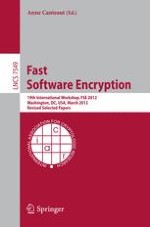2012 | Buch
Fast Software Encryption
19th International Workshop, FSE 2012, Washington, DC, USA, March 19-21, 2012. Revised Selected Papers
herausgegeben von: Anne Canteaut
Verlag: Springer Berlin Heidelberg
Buchreihe : Lecture Notes in Computer Science
